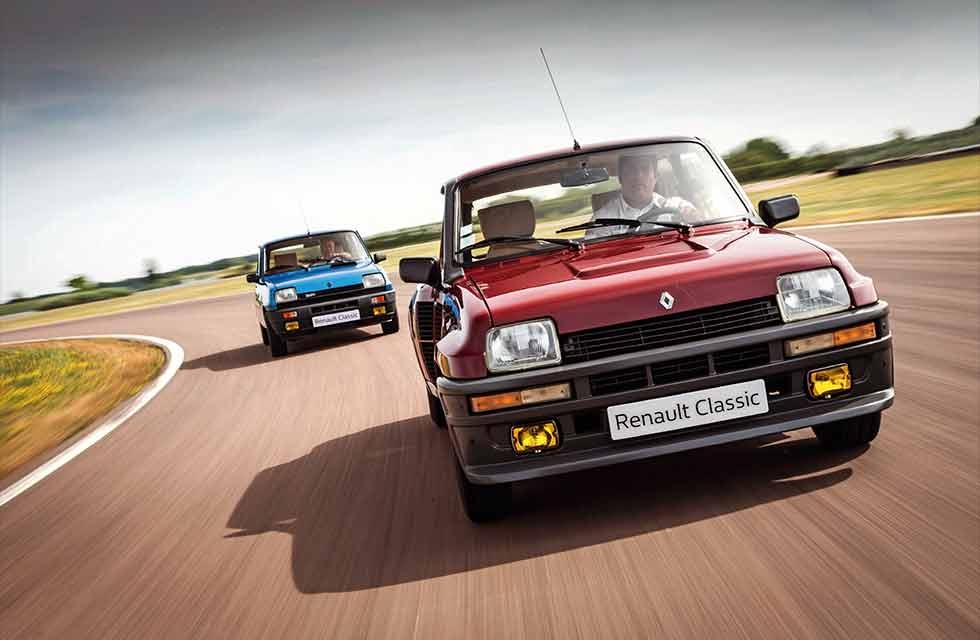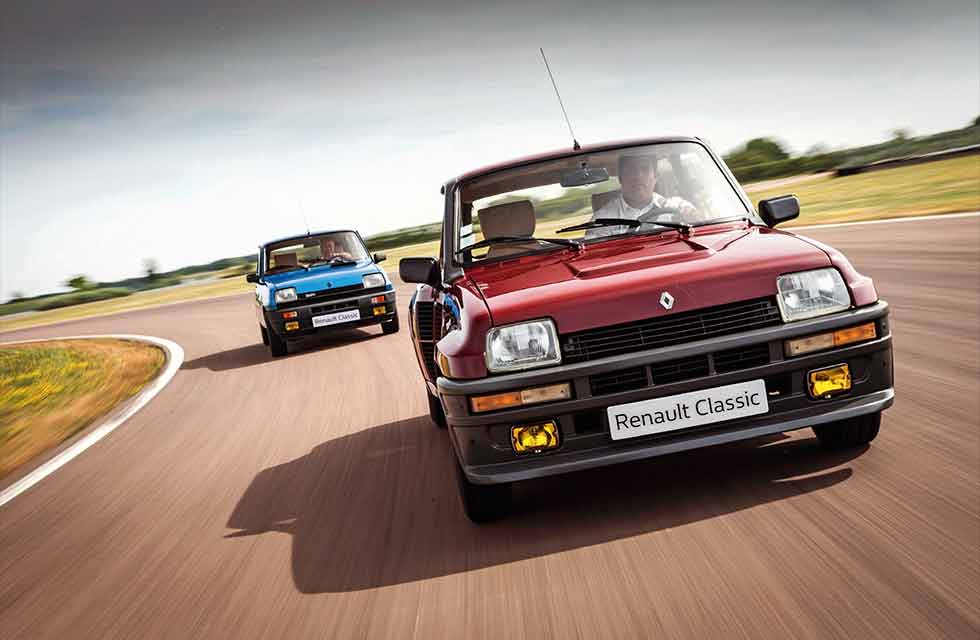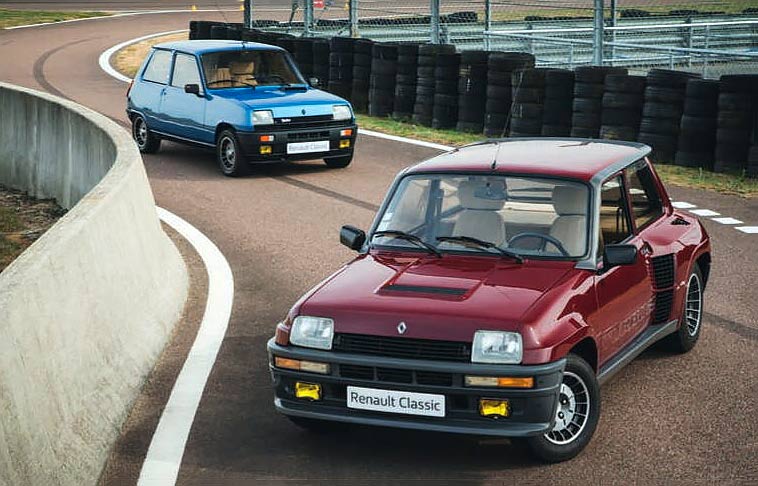
Renault’s wild child – Jack Phillips celebrates La Régie’s blown era with a roadgoing Gordini and 5 Turbo. Spinning its own yarn. The Renault 5 Turbo 2 and its Gordini ancestor were both born out of competition, and soon won far more than just pots. Words Jack Phillips. Photography Luc Lacey.
RENAULT 5 TURBOS: SMALL BUT MIGHTY
Think Renault and turbo, and just one thing will spring to mind. Not the 18, the first turbocharged production Renault, not René Arnoux versus Gilles Villeneuve at Dijon-Prenois. A pumpedup Renault 5 in bright red or electric blue, with gaping wide intakes, will fill your mind’s eye. That it beats one of Formula One’s most memorable and replayed duels is testament to how special the Renault 5 Turbo is. Not was; is. It transcended generations. Kids dreamed of them in the 1990s (I did), long after its moment had passed, and its only tangible link was the sanitised but still entertaining GT Turbo.

First came its spiritual predecessor, albeit sans turbo: the Renault 5 Alpine, known as Gordini in the UK because Chrysler had the name Alpine tucked safely somewhere under its web of arms. Whatever; Gordini sounds faster, anyway. The Gordini landed in Britain the same year as the right-hand-drive VW Golf GTi and the year the great Amédée died, 1979, producing 93bhp from its Gordini-tuned 1.4-litre Cléon-Fonte/Sierra engine. The bored-out 1.2’s twin-choke Weber helped double the 46bhp output of the standard family hatch.
‘It’s absorbing, addictive, and everything you hoped it would be. In the right hands it’s a tail-out slider; in the wet it’s that for all’
While it couldn’t match the Golf to 60mph from a standing start, it would match the BMW 525, Rolls-Royce Silver Shadow or Rover 2600, as some contemporary reports pointed out. But the Alpine was a car some were familiar with already, because in 1978 Jean Ragnotti had scored a remarkable second place on the Rallye Monte-Carlo ahead of teammate Guy Fréquelin, beaten only by Jean-Pierre Nicolas’ Porsche 911. Walter Röhrl could manage only fourth.

“The Gordini was spectacular,” recalls the small and smiling Ragnotti, “but the car had such an old engine. The car really moved about, slipping and sliding around, especially the back because the tyres were tiny. It was a fabulous training school, I learnt a huge amount.”
On the road it was stiffer than any 5 before it, with anti-roll bars front and rear and 5% thicker torsion bars, and it was visually more aggressive than the standard slant-backed hatch that was nearing a decade old. A front lip gave it a lower look, housing those tinted French fogs – Cibié, naturally. At more than £4500 it wasn’t cheap, but it was a snip compared to what was to come.
‘The Gordini Turbo is a slim and pretty little thing, and in a more obvious way than its brash big Turbo 2 brother’
Around the same time the naturally aspirated Gordini met British roads, Renault was grabbing headlines across the world from its own backyard. It was finding redemption, too, because its against-the-DFV-grain turbocharged F1 engine was taking its breakthrough victory after two years in the doldrums with an unreliable, single-turbo 1.5-litre V6 engine. After 13 retirements in 16 races across 1977 and ’1978, fourth at Watkins Glen had been a rare highlight for a troubled project and the only points scored. There had been progress elsewhere, not least at Le Mans.
Engine unreliability meant the home and race favourites lost out to Porsche in 1977, but Jean-Pierre Jaussaud and Didier Pironi made amends 12 months later with the 2-litre V6. Job done, full focus went to F1 and chasing world acclaim. “The English thought the turbocharger was a mistake,” says one-time 5 Turbo owner Arnoux. “Everybody was saying it wouldn’t work. But I was told, ‘René, you’ll see. Everyone will want to drive with that engine!’ It never occurred to me that it wouldn’t work.”
Finally, after just one finish apiece in six starts to begin the season, came Jabouille’s all-French win: French Grand Prix, French team, French driver, engine, tyres, and Elf oil. La justification. The RS10 had taken over from the RS01, with twin KKK turbochargers, and changed F1 just as Cooper had two decades before. Unlike Cooper, La Régie could capitalise and market to the watching world on the back of this success.
Renault had just the car to be its turbocharged figurehead already waiting in the wings. Radicalising the 5 was chosen instead of the 20, because the Turbo would add some much-needed jazz to the staid compact’s range. More importantly, ‘Project 822’ would be better to take Renault on to the World Rally stage proper.
Product director Jean Terramorsi was the visionary behind the programme, with the foresight to devise it as far back as 1976, but fate intervened to deny him the chance to see the shape of its success and Le Mans winner Gérard Larrousse assumed its responsibility. A month after Terramorsi succumbed to heart problems in August ’76, a prototype Renault 5 Turbo was reportedly ready, the styling models created by Bertone under Renault’s in-house direction.
Turin’s focus, Marc Deschamps’ in particular, was on the striking rear and the first sketch had been completed in May; Marcello Gandini worked up the plaster model months later. Suitably impressed, helped in no small part by the model’s tactical placement at Renault HQ to ensure it met the right eyeballs, production was signed off and Heuliez was tasked with working the concept into a real-world car.
Larrousse was the first to drive a working prototype, in 1978, before European 2-litre sports car champion Alain Serpaggi took on the testing and developing of the earliest working example around Dieppe, where Alpine was and is still based. A red shell of a car was displayed at the Paris Motor Show, where many saw it merely as a concept car and nothing more, and the press was given a glimpse of Serpaggi’s so-called ‘black prototype’ at the end of the season at a special Renault celebration event held at Paul Ricard.
‘A mid-engine, 1.4-litre, Renault R5-turbo!’ exclaimed Motor Sport. ‘This car is not a joke. The idea is that a production version may materialise and Renault attack the World Rally title again, but after success has/has not been achieved in Formula One.’
Behind the driver was to be the same old pushrod 1397cc engine as found in the Gordini, hidden away beneath a jigsaw of a flat-pack-furniture- like chest covered in garish red or blue carpet – whichever was the opposite of the exterior paint. But instead of 93bhp, the Garrett T3 turbocharger wound output to 160bhp, with compression shrunk to 7:1, and the engine was mated to the Type 369 gearbox from the PRV V6 Alpine A310 rather than that from the 16.
In competition spec, a further 100bhp could be found. The body panels – bonnet, doors and roof – were lightened by using aluminium to save around 20kg, the windows were thinned by 1mm, while plastic and lighter steel provided the wings to trim a further 30kg from the car. It eventually tipped the scales at comfortably less than 1000kg. Roadholding was guaranteed to be spectacular with the R5 Alpine’s competition suspension at the front and the A310’s at the rear.
Yet despite its 40/60 weight distribution it still looked like a 5, not least when sitting beside a Gordini – as the Turbo 2 is today at a race track in mid-France. The lines are unmistakably there, the protruding tail-lights, too. But the arches lurch out to widen the car by almost a foot – whether the alloy wheels they shroud are as pretty as the early Gordini’s is another matter. Following the Brussels Motor Show in 1980 orders opened in July, with Renault required to build 400 units to ensure the Turbo could fulfil its primary function in the Group 4 World Rally Championship. Left-hand-drive only, and never officially for UK drivers, were the drawbacks.
Its competitive life began spectacularly, with Ragnotti powering a works Turbo to nine of the first 13 Tour de Corse stage wins, only to retire with alternator trouble. In January ’1981 Ragnotti scored his and the car’s big victory, the Rallye Monte-Carlo, but only in claiming the Tour de Corse the following year did Ragnotti and the 5 Turbo return to the WRC podium.
Road drivers were offered a taste of the R5 Turbo that same year, when the Gordini gained a Garrett T3 turbo. Three years and one turbo had naturally elevated the Gordini’s price to £5750 – though ‘only’ £425 more than the normally aspirated variant – but buyers could enjoy 110bhp and 108lb ft of torque, the latter up by nearly a third. Perhaps more importantly, it was finally a match for the Golf.
If you’re R5 inclined, the Gordini Turbo is a slim and pretty little thing, and in a more obvious way than its brash big brother. Its thick-bolstered seats feel sporting enough, but the dash is stock 5 and its light-grey plastic switches and orangey-red- on-black dials date it. The three-spoke Alpine-badged wheel lies awkwardly flat on a short column, which takes some getting used to, but it is pleasingly heavy and gives back what you put in. A letterbox air intake directly ahead skews the symmetry looking over the bonnet. Once it has been persuaded unwillingly to noisily fire, all metal clatters and clangs, the Gordini is predictably nippy – when the turbo quietly wakes. The car squats into turns with a roll, but not in a comic, stock 5 way. Its gearbox is close – “mayonnaise!” laughs the Renault man in the passenger seat, ‘like stirring a bowl of treacle’ wrote Autocar – and takes some acclimatising.
Early French customers could choose between standard or close-ratio ’boxes, and also power steering; the Brits had neither: standard ’box and unpowered steering only.
The Gordini doesn’t have the sheer drama of its more celebrated stablemate, but it could be used as a daily. It does have a boot, after all, rather than a shelf that will cook your shopping before you get it home. But, as was intended, the Gordini Turbo is a mere warm-up for what came a year later, and what awaits behind today in La Ferté-Gaucher’s technical-circuit pitlane.
With public demand for the 400 R5 Turbo homologation specials so strong that more than 1800 were made, Renault in 1983 unleashed the Turbo 2 to further capitalise on that competition kudos. Out went the aluminium panels in favour of cheaper and stronger steel, and out went the garish interior in favour of the Gordini’s.
But reverse is a dogleg to the left, unlike the Gordini’s being safely where sixth would be, and perils await. The tricky ’box will guide you unwittingly from third to fourth instead of second and swallow all of your progress, ending any expectation of the turbo engaging when you accelerate out of a corner. Any over-correction and you’re in a disastrous reverse.
With momentum gone, the lack of low-down power is crushing. But get it right and you’re rewarded with a surging acceleration that’s progressive beyond expectations and reputation. Comfortably within its limits the Turbo 2 feels on side, safe. There is grip to spare in spades without feeling dull. It (and the driver) fizzes with every downchange, and the whistling turbo commands the hairs on the back of your neck to rise. You soon forget that flat steering wheel – this time with Renault diamond at its centre, the Turbo 1’s bizarre one long gone – that makes you sit too upright, or that the clutch bites high. You forget that it’s in any way related to Le Car, even. It’s absorbing, addictive, and everything you hoped. In the right hands it’s a tail-out slider; in the wet you suspect it’s that for everyone.
While the Turbo 2 was being toned down for the masses, however slightly, the competition car was being upgraded to 285bhp Group B spec via the Tour de Corse kit, before the F1-inspired 1.5-litre and DPV anti-lag system combined for the ultimate R5: the 350bhp Maxi. Ragnotti used the latter to take back the Tour de Corse trophy in 1985. But there was little celebration for the R5’s fourth and final WRC victory, when local Joaquim Moutinho won the tragic 1986 Portuguese Rally that claimed the lives of three spectators and from which the works teams withdrew, pushing Group B nearer its end.
That low total of four wins at the top table ensured it was to be a cult hero rather than an all-conquering star of Group B. But on the road it’s both, and no matter how much you try and reason with the usability, practicality and relative cheapness of the Gordini, the Turbo is the ultimate. And the one everyone would take home, probably even Amédée.
Renault 5 Gordini Turbo
Sold/number built 1982-’1986 /5m (all 5s)
Construction steel monococque
Engine iron-block, alloy-head, ohv 1397cc ‘four’, with Weber 32 DIR 75 carburettor and Garrett T3 turbocharger
Max power 110bhp @ 6000rpm
Max torque 108.5lb ft @ 4000rpm
Transmission five-speed manual, FWD
Suspension independent, at front by double wishbones, longitudinal torsion bars rear trailing arms, transverse torsion bars; telescopic dampers, anti-roll bar f/r
Steering rack and pinion
Brakes discs/drums, with servo
Length 11ft 8in (3555mm)
Width 4ft 11 4/5 in (1520mm)
Height 4ft 7 ½ in (1410mm)
Wheelbase 4ft 10 ½ in (2400mm)
Weight 1874lb (850kg)
0-60mph 9.8 secs
Top speed 116mph
Mpg 30.1
Price new £5750 (1982)
Price now £15,000
Clockwise: Garrett turbo and Gordini’s magic pushed output past 100bhp; badge was replicated on window sticker; slender Gordini corners well despite looking top-heavy.
Renault 5 Turbo 2
Sold/number built 1983-’1986/3175
Construction steel monocoque
Engine iron-block, alloy-head, ohv 1397cc ‘four’, with Bosch K-Jetronic fuel injection and Garrett T3 turbocharger
Max power 160bhp @ 6000rpm
Max torque 155lb ft @ 4000rpm
Transmission five-speed manual, RWD
Suspension independent, at front by double wishbones rear unequal-length wishbones; coil springs, torsion bars, telescopic dampers, anti-roll bar f/r
Steering rack and pinion
Brakes discs, with servo
Length 12ft ¼ in (3664mm)
Width 5ft 9in (1752mm)
Height 4ft 4in (1323mm)
Wheelbase 7ft 11 ½ in (2430mm)
Weight 2138lb (970kg)
0-60mph 6.9 secs
Top speed 124.5mph
Mpg 31.4
Price new n/a
Price now £65,000-90,000
Clockwise: Turbo 2 interior was shared to save costs; intricate rear-mounted solution; aggressive silhouette has become iconic with cult status.
TRACK RACER VS RALLY MONSTER
Just imagine the heat haze. A gridful of Renault 5 Turbos lining up at Le Mans for a round of the Europa Cup as a curtain-raiser to the grand race must have looked more mirage than 20 or so defined cars. Because it doesn’t take long for the heat to rise to insufferable levels, even after a handful of passenger laps around the small Aérodrome de la Ferté-Gaucher circuit. Little changed from the 160bhp production car; the padded doorcards remain in the single-make championship car. It’s a world away from the modern Clio Cup purpose-built racers.
The rear wants to lead, peering out from behind to give itself a better view past the front wheels, pushing the car around on slippery warm tyres. It’s perhaps happiest when it dips a wheel over the kerb, skipping into the dirt, which leads us to the stripped out, gauge-filled 285bhp Group B Tour De Corse competition car (with Alain Serpaggi at the helm, no less).
Everything is amplified. The revs are kept high to mitigate the turbo’s intervention, and the car just keeps pulling. The heat is unbearable, seemingly reaching furnace levels within a few corners, rendering thoughts of racing them around African stages simply unimaginable.
It’s louder, the turbo whistle being carried around with you via unshakeable tinnitus long after the ungainly clamber out, and the slides are longer. Yet the car is more precise than the grainy sideways YouTube videos will have you believe. But Serpaggi is finger-tipping around, grinning, enjoying being back in his home-from-home. Just imagine what the Maxi must be like…
From top: Europa Cup car was a stock road car, even down to the padded doorcards; Tour de Corse upgrade made it a Group B rally thoroughbred.






